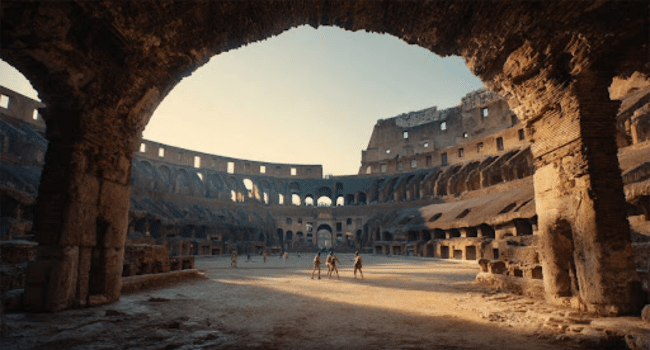Table of Contents
Gladiators are among the most iconic figures of Ancient Rome. Known for their fierce battles in the Colosseum and other amphitheaters across the Roman Empire, these fighters have captivated the imagination of historians, movie directors, and travelers for centuries. But who were they really? What was their life like, and where can you explore their legacy today in Rome?
“Relive the drama of ancient gladiatorial combat while comfortably exploring Rome’s historical marvels. Book your Golf Cart Tours in Rome today and experience the Colosseum like never before!”
Who Were the Gladiators?
Gladiators were mostly slaves, prisoners of war, or condemned criminals who were trained in special schools called ludi. However, some free men volunteered to become gladiators, lured by fame, money, or personal glory. They were trained to fight using various weapons and styles—each with its own name and strategy, such as the retiarius (net and trident fighter) or the murmillo (heavily armored with a gladius and shield).
Far from being mindless killers, many gladiators were respected performers, known by name and followed like modern-day athletes. Some even gained their freedom and became instructors or celebrities in Roman society.
The Colosseum: The Arena of Blood and Glory
No discussion of gladiators would be complete without mentioning the Colosseum. Also known as the Flavian Amphitheatre, it could hold over 50,000 spectators who gathered to watch combat between gladiators, wild animal hunts, and even staged naval battles.
The underground chambers, known as the hypogeum, housed wild animals, stage machinery, and the gladiators themselves, waiting for their turn to rise to the arena through trap doors. Visiting the Colosseum today with a private guide unveils these secrets in vivid detail.
Gladiator Schools and Training
Gladiators didn’t just appear in the arena without preparation. They trained rigorously in dedicated facilities known as ludi gladiatorii. The most famous of these was the Ludus Magnus, located just east of the Colosseum. This training center was connected to the amphitheater by an underground tunnel, ensuring that gladiators could be transported directly to the arena unseen by the public.
Today, you can visit the ruins of Ludus Magnus, which still display the oval training arena and some of the surrounding structures. A stop here during a Golf Cart Tours in Rome offers a deeper look into the daily life of a gladiator.
Types of Gladiators
The Roman Empire boasted many types of gladiators, each with specific gear and fighting styles. Some of the most well-known include:
- Retiarius: Armed with a net and trident, relying on speed and agility.
- Murmillo: Equipped with a gladius and a large rectangular shield, wearing a fish-shaped helmet.
- Thraex: Wielding a curved sword and small shield, inspired by Thracian warriors.
- Secutor: Similar to the murmillo but with a smooth helmet to avoid the net of the retiarius.
Each duel was not just a test of strength but a strategic performance, often ending only when one fighter yielded or was fatally wounded.
Myths and Reality
Hollywood has portrayed gladiators as ultimate warriors, constantly fighting to the death. In truth, gladiator bouts were often more regulated and rarely ended in fatality. Organizers invested heavily in these fighters and preferred to keep them alive for future games. The concept of the “thumbs up” or “thumbs down” deciding a gladiator’s fate is also debated by historians. In reality, it may have been a closed fist or gesture by the emperor or editor that sealed the fate of the defeated.
Where to Experience Gladiator History in Rome
If you’re fascinated by the world of Roman gladiators, there are several must-visit locations in Rome where their stories come alive:
- Colosseum: Walk the arena floor and tour the underground chambers with a private guide.
- Ludus Magnus: The remains of Rome’s largest gladiator training school.
- Roman Forum: Explore the political and social heart of ancient Rome, where decisions about the games were made.
- Capitoline Museums: Home to sculptures, weapons, and artifacts related to gladiatorial combat.
- Baths of Caracalla: Used by gladiators for recovery and relaxation after battle.
See It All with a Golf Cart Tour
Covering all these historic sites in a single day can be challenging—unless you choose a guided golf cart tour. With Golf Cart Tours in Rome, you can explore the most iconic gladiator landmarks comfortably and efficiently, with a local guide narrating their stories. You’ll cruise past the Colosseum, glide by Ludus Magnus, and pause for photos at hidden gladiatorial spots you’d never find on your own.
The tours are customizable, accessible, and perfect for couples, families, or solo travelers eager to make the most of their time in the Eternal City.
The gladiators of ancient Rome remain one of the most fascinating aspects of the Empire’s culture. They were more than warriors; they were symbols of strength, endurance, and public spectacle. By visiting their historic grounds and understanding their world, you connect with Rome’s vibrant past in a truly meaningful way.
Whether you’re a history buff, a fan of Roman architecture, or simply curious, a golf cart tour is your ticket to unlocking this timeless story.
